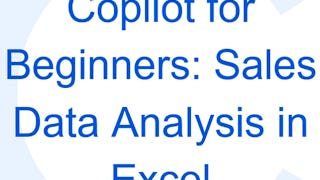By the end of this project, you will have developed LibreOffice Base queries that provide data for use in sales analysis. An organization that sells products or services finds it useful to know which products are selling, whether they are priced appropriately, and which customers are purchasing them. Providing that kind of data gives the organization better targets for fine tuning its product mix and customer base.


Recommended experience
What you'll learn
Describe the contents and organization of a typical sales-related database.
Use the LibreOffice Base Query Design tool to write multiple-table queries.
Retrieve and prepare data for sales analysis.
Skills you'll practice
Details to know

Add to your LinkedIn profile
Only available on desktop
See how employees at top companies are mastering in-demand skills

Learn, practice, and apply job-ready skills in less than 2 hours
- Receive training from industry experts
- Gain hands-on experience solving real-world job tasks
- Build confidence using the latest tools and technologies

About this Guided Project
Learn step-by-step
In a video that plays in a split-screen with your work area, your instructor will walk you through these steps:
Review the Sales database tables to become familiar with their contents while you explore the LibreOffice Base user interface.
Generate a LibreOffice Base query that calculates the amount ordered by each customer and sorts the list in order from highest to lowest order/sales amount.
Generate a LibreOffice Base query that compares a customer's sales amounts to determine the effect of a product's price increase.
Generate LibreOffice Base queries that calculate for each customer the number of times each product has been ordered and the total quantity ordered of each product.
Generate LibreOffice Base queries to summarize first- and second-quarter sales by product, and then use a third query to compare quarterly sales.
Recommended experience
Prior exposure to relational databases and familiarity with LibreOffice Base queries is recommended.
5 project images
Instructor

Offered by
How you'll learn
Skill-based, hands-on learning
Practice new skills by completing job-related tasks.
Expert guidance
Follow along with pre-recorded videos from experts using a unique side-by-side interface.
No downloads or installation required
Access the tools and resources you need in a pre-configured cloud workspace.
Available only on desktop
This Guided Project is designed for laptops or desktop computers with a reliable Internet connection, not mobile devices.
Why people choose Coursera for their career




You might also like
 Status: Free
Status: Free Status: Free
Status: Free

Open new doors with Coursera Plus
Unlimited access to 10,000+ world-class courses, hands-on projects, and job-ready certificate programs - all included in your subscription
Advance your career with an online degree
Earn a degree from world-class universities - 100% online
Join over 3,400 global companies that choose Coursera for Business
Upskill your employees to excel in the digital economy
Frequently asked questions
By purchasing a Guided Project, you'll get everything you need to complete the Guided Project including access to a cloud desktop workspace through your web browser that contains the files and software you need to get started, plus step-by-step video instruction from a subject matter expert.
Because your workspace contains a cloud desktop that is sized for a laptop or desktop computer, Guided Projects are not available on your mobile device.
Guided Project instructors are subject matter experts who have experience in the skill, tool or domain of their project and are passionate about sharing their knowledge to impact millions of learners around the world.



